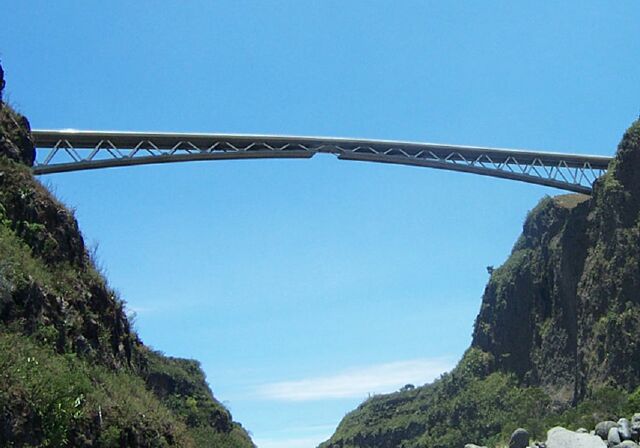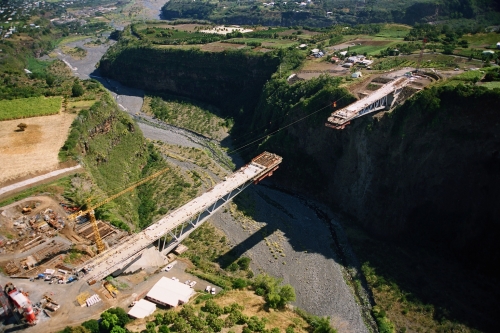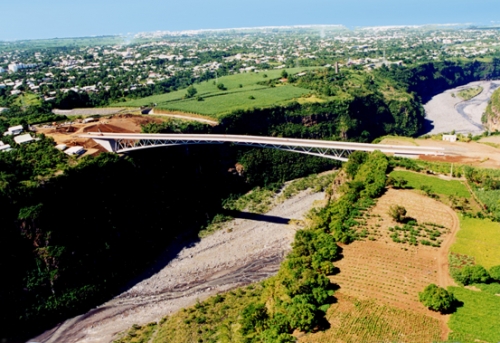Difference between revisions of "Bras de la Plaine Bridge"
(Created page with '<div style="font-size: 25px; text-align: center;"> Sioule Viaduct<br /> Viaduc Sioule<br /> Pontgibaud, Auvergne, France<br /> 492 feet high / 150 meters high<br /> 632 foot span…') |
|||
| Line 1: | Line 1: | ||
<div style="font-size: 25px; text-align: center;"> | <div style="font-size: 25px; text-align: center;"> | ||
| − | + | Bras de la Plaine Bridge<br /> | |
| − | + | Pont Bras de la Plaine<br /> | |
| − | + | Mahavel, Réunion Island, France<br /> | |
| − | + | (475) feet high / 145 meters high<br /> | |
| − | + | 921 foot span / 281 meter span<br /> | |
| − | + | 2002<br /> | |
| − | [[File: | + | [[File:1PontBrasDeLaPlaine.jpg|1000px|center]] |
</div> | </div> | ||
| − | + | Opened in 2002, the Bras de la Plaine bridge is an unusual cantilevered truss with a huge main span of 922 feet (281 mtrs). Réunion Island is a French territory located east of Madagascar Island in the Indian Ocean. Just 35 miles (56 kms) across, the region has become a popular tourist getaway as well as a permanent home to more than 800,000 residents. Travel between the many coastal communities on Réunion Island has always been through a network of older, two lane roads that traverse in and around many deep rifts cut from rain runoff tumbling down the tall volcanic peaks that created Réunion Island. | |
| − | + | The impressive Bras de la Plaine bridge crosses one of the deeper gorges on the island. The 922 foot (281 mtr) main span is essentially two bridges, each composed of a cantilevered warren truss that meet in the middle but are largely supported by the weight of a massive 7,500 ton dead man foundation on either side of the canyon. The transition between these two halves of the bridge was made even more noticeable by a change in grade at the crown from 1 to 5 percent. To construct the bridge, two 131 foot (40 meter) high pylons were erected 1,362 feet (415 mtrs) apart. The slender span is a perfect marriage of our two most basic building materials with two vertical planes of steel tubing sandwiched between two horizontal, thin slabs of concrete. | |
| − | + | The Bras de la Plaine had its spotlight stolen in 2009 when the 30 mile (50 km) Route des Tamarins opened on the west side of the island to relieve congestion. Crossing dozens of huge ravines, the new route required the construction of 3 tunnels, 9 interchanges and 4 major bridges including the Saint Paul, the Trois Bassins, the Ravine Fontaine and the Grande Ravine. Crossing a chasm 558 foot (170 mtr) deep, the Grande Ravine also has a unique design with shallow strut frames supporting a 945 foot (288 mtr) long steel box girder. The two concrete struts are counterweighted on the back sides by two large abutments filled with tons of soil in a method similar to the Bras de la Plaine. | |
| − | + | [[File:2BrasdelaPlaineAtelierAmedeo&Associes.JPG|1000px|center]] | |
| − | + | ras de la Plaine Bridge image by Atelier Amedeo & Associes. | |
| − | |||
| − | |||
| − | |||
| − | |||
| − | |||
| − | |||
| − | |||
| − | [[File: | ||
| − | |||
| − | |||
| − | |||
| − | |||
| − | |||
| − | |||
| − | |||
| − | |||
| − | |||
| − | [[File: | + | [[File:3BrasdelaPlaineAtelierAmedeo&Associes.JPG|1000px|center]] |
| − | + | ras de la Plaine Bridge image by Atelier Amedeo & Associes. | |
[[Category:Bridges in France]] | [[Category:Bridges in France]] | ||
Revision as of 03:11, 5 November 2009
Bras de la Plaine Bridge
Pont Bras de la Plaine
Mahavel, Réunion Island, France
(475) feet high / 145 meters high
921 foot span / 281 meter span
2002
Opened in 2002, the Bras de la Plaine bridge is an unusual cantilevered truss with a huge main span of 922 feet (281 mtrs). Réunion Island is a French territory located east of Madagascar Island in the Indian Ocean. Just 35 miles (56 kms) across, the region has become a popular tourist getaway as well as a permanent home to more than 800,000 residents. Travel between the many coastal communities on Réunion Island has always been through a network of older, two lane roads that traverse in and around many deep rifts cut from rain runoff tumbling down the tall volcanic peaks that created Réunion Island.
The impressive Bras de la Plaine bridge crosses one of the deeper gorges on the island. The 922 foot (281 mtr) main span is essentially two bridges, each composed of a cantilevered warren truss that meet in the middle but are largely supported by the weight of a massive 7,500 ton dead man foundation on either side of the canyon. The transition between these two halves of the bridge was made even more noticeable by a change in grade at the crown from 1 to 5 percent. To construct the bridge, two 131 foot (40 meter) high pylons were erected 1,362 feet (415 mtrs) apart. The slender span is a perfect marriage of our two most basic building materials with two vertical planes of steel tubing sandwiched between two horizontal, thin slabs of concrete.
The Bras de la Plaine had its spotlight stolen in 2009 when the 30 mile (50 km) Route des Tamarins opened on the west side of the island to relieve congestion. Crossing dozens of huge ravines, the new route required the construction of 3 tunnels, 9 interchanges and 4 major bridges including the Saint Paul, the Trois Bassins, the Ravine Fontaine and the Grande Ravine. Crossing a chasm 558 foot (170 mtr) deep, the Grande Ravine also has a unique design with shallow strut frames supporting a 945 foot (288 mtr) long steel box girder. The two concrete struts are counterweighted on the back sides by two large abutments filled with tons of soil in a method similar to the Bras de la Plaine.
ras de la Plaine Bridge image by Atelier Amedeo & Associes.
ras de la Plaine Bridge image by Atelier Amedeo & Associes.


